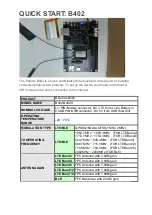Frequency Modulated Phase Locked Loop and System Clocks (FMPLL)
MPC5565 Microcontroller Reference Manual, Rev. 1.0
11-30
Freescale Semiconductor
Rounding this value to the closest integer yields 48, which is entered into the EXP field for this example.
This routine corrects for process variations, but because temperature can change after calibration is
performed, the variation caused by temperature drift remains. This frequency modulation calibration
system is also voltage dependent, so if the supply changes after the sequence occurs, errors incurred are
not corrected. The calibration system reuses the two counters in the lock detect circuit, and the reference
and feedback counters. The reference counter remains clocked by the reference clock, but the feedback
counter is clocked by the ICO clock.
When the calibration routine is initiated by writing to the DEPTH bits, the CALPASS status bit is
immediately set and the CALDONE status bit is immediately cleared.
When calibration is induced, the ICO is given time to settle. Then both the feedback and reference counters
start counting. Full ICO clock cycles are counted by the feedback counter during this time to give the initial
center frequency count. When the reference counter has counted to the programmed number of reference
count cycles, the input to the feedback counter is disabled and the result is placed in the COUNT0 register.
The calibration system then enables modulation at programmed
Δ
Fm. The ICO is given time to settle. Both
counters are reset and restarted. The feedback counter begins to count full ICO clock cycles again to obtain
the delta-frequency count. When the reference counter has counted to the new programmed number of
reference count cycles, the feedback counter is stopped again.
The delta-frequency count minus the center frequency count (COUNT0) results in a delta count
proportional to the reference current into the modulation D/A. That delta count is subtracted from the
expected value given in the EXP field of the FMPLL_SYNCR resulting in an error count. The sign of this
error count determines the direction taken by the calibration D/A to update the calibration current. After
obtaining the error count for the present iteration, both counters are cleared. The stored count of COUNT0
is preserved while a new feedback count is obtained, and the process to determine the error count is
repeated. The calibration system repeats this process eight times, once for each bit of the calibration D/A.
After the last decision is made, the CALDONE bit of the SYNSR is written to a one. If an error occurs
during the calibration routine, then CALPASS is immediately written to a zero. If the routine completed
successfully then CALPASS remains a one.
Table 11-10. Multiplied Factor Dividers with M Values
MFD
M
0–2
960
3–5
640
6–8
480
9–14
320
15–20
240
21–31
160
Summary of Contents for MPC5565
Page 18: ...MPC5565 Microcontroller Reference Manual Devices Supported MPC5565 MPC5565 RM Rev 1 0 09 2007...
Page 34: ...MPC5565 Reference Manual Rev 1 0 Freescale Semiconductor 15...
Page 35: ...MPC5565 Reference Manual Rev 1 0 16 Freescale Semiconductor...
Page 553: ...Flash Memory MPC5565 Microcontroller Reference Manual Rev 1 0 13 38 Freescale Semiconductor...
Page 559: ...SRAM MPC5565 Microcontroller Reference Manual Rev 1 0 14 6 Freescale Semiconductor...
Page 973: ...Preface MPC5565 Microcontroller Reference Manual Rev 1 0 21 36 Freescale Semiconductor...
Page 1153: ...Calibration MPC5565 Microcontroller Reference Manual Rev 1 0 B 8 Freescale Semiconductor...

















